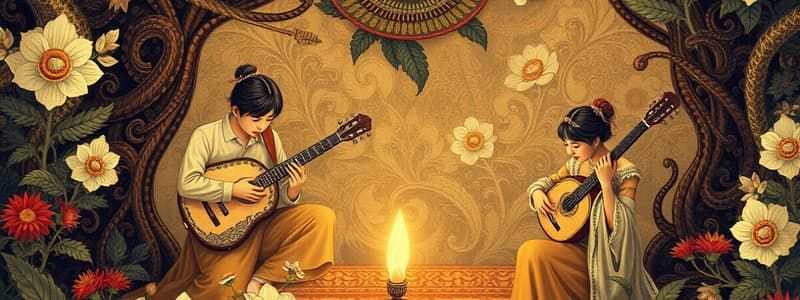Podcast
Questions and Answers
What is the main tonal system used in Indonesian music?
What is the main tonal system used in Indonesian music?
- Chromatic
- Slendro and Pelog (correct)
- Diatonic
- Pentatonic
What are the two types of Gamelan?
What are the two types of Gamelan?
Javanese and Balinese
Slendro contains seven tones.
Slendro contains seven tones.
False (B)
Match the following Indonesian musical instruments with their categories:
Match the following Indonesian musical instruments with their categories:
The Slendro scale primarily expresses ______.
The Slendro scale primarily expresses ______.
The Pelog scale primarily expresses ______.
The Pelog scale primarily expresses ______.
What type of music does Javanese Gamelan typically accompany?
What type of music does Javanese Gamelan typically accompany?
What distinguishes Balinese Gamelan from Javanese Gamelan?
What distinguishes Balinese Gamelan from Javanese Gamelan?
Which of the following is a characteristic of the Slendro tonal system?
Which of the following is a characteristic of the Slendro tonal system?
The Pelog tonal system is associated with sadness.
The Pelog tonal system is associated with sadness.
What are two types of gamelan mentioned?
What are two types of gamelan mentioned?
Match the following instruments with their classifications:
Match the following instruments with their classifications:
What characteristic differentiates Javanese gamelan from Balinese gamelan?
What characteristic differentiates Javanese gamelan from Balinese gamelan?
The tonal system with seven notes is called ______.
The tonal system with seven notes is called ______.
What does the term 'Nusantara' refer to?
What does the term 'Nusantara' refer to?
Flashcards are hidden until you start studying
Study Notes
Southeast Asian Music - Indonesia
- "Bhinneka Tunggal Ika" serves as the national motto of Indonesia, symbolizing unity in diversity.
- Nusantara refers to the Indonesian archipelago, highlighting cultural and musical richness across various regions.
Basic Elements of Indonesian Music
- Rhythm: A crucial component, establishing the pace and structure of compositions.
- Melody: Central to the music's emotive expression, varies between scales.
- Form: The overall structure of a composition, guiding the flow of music.
- Timbre: The distinct quality or tone of instruments, contributing to the music's identity.
Indonesian Music Tonal System
-
Slendro:
- A five-tone pentatonic scale often associated with male expression.
- Evokes feelings of sadness, using the sequence 6123561.
-
Pelog:
- A seven-tone pentatonic scale linked with female expression.
- Conveys festivity and cheerfulness, utilizing the scale 1234567.
Indonesian Music Mnemonics
- Specific mnemonics assist musicians in remembering the tonal sequences for Slendro and Pelog.
Gamelan
- A traditional ensemble integral to Indonesian cultural performances, featuring a range of percussion instruments.
- Characterized by intricate interlocking patterns and communal participation.
Xylophones (Idiophones)
- Gendèr: A mallet-played instrument with bronze keys, providing melodic support.
- Gambang: A wooden xylophone, used for both melody and rhythm in various traditional performances.
- Saron: A metallophone with a rich, resonant sound, commonly prevalent in gamelan music.
Gongs (Idiophones)
- Bonang: A series of small gongs played melodically, essential in gamelan ensembles.
- Kenong: Larger gongs that punctuate the rhythm, adding depth to the musical structure.
- Kempul: Hanging gongs, contributing to the harmonic framework of the composition.
- Gong Ageng: The largest gong, serves as the foundational sound in gamelan music.
Drums (Membranophones)
- Kendhang: The main drum in gamelan, critical for maintaining rhythm and guiding tempo during performances.
Angklung
- A traditional bamboo instrument that produces unique sounds when shaken, often used in ensembles.
Two Types of Gamelan
-
Javanese Gamelan:
- More traditional, featuring strings and flutes.
- Suited for vocal accompaniment and slower, gentler musical styles.
- Often performed in royal palaces.
-
Balinese Gamelan:
- A modern and contemporary genre with a strong percussion emphasis.
- Open to infusions of Western music, utilizing more metallophones than gongs.
- Features livelier styles with a generally lower pitch.
Southeast Asian Music - Indonesia
- "Bhinneka Tunggal Ika" serves as the national motto of Indonesia, symbolizing unity in diversity.
- Nusantara refers to the Indonesian archipelago, highlighting cultural and musical richness across various regions.
Basic Elements of Indonesian Music
- Rhythm: A crucial component, establishing the pace and structure of compositions.
- Melody: Central to the music's emotive expression, varies between scales.
- Form: The overall structure of a composition, guiding the flow of music.
- Timbre: The distinct quality or tone of instruments, contributing to the music's identity.
Indonesian Music Tonal System
-
Slendro:
- A five-tone pentatonic scale often associated with male expression.
- Evokes feelings of sadness, using the sequence 6123561.
-
Pelog:
- A seven-tone pentatonic scale linked with female expression.
- Conveys festivity and cheerfulness, utilizing the scale 1234567.
Indonesian Music Mnemonics
- Specific mnemonics assist musicians in remembering the tonal sequences for Slendro and Pelog.
Gamelan
- A traditional ensemble integral to Indonesian cultural performances, featuring a range of percussion instruments.
- Characterized by intricate interlocking patterns and communal participation.
Xylophones (Idiophones)
- Gendèr: A mallet-played instrument with bronze keys, providing melodic support.
- Gambang: A wooden xylophone, used for both melody and rhythm in various traditional performances.
- Saron: A metallophone with a rich, resonant sound, commonly prevalent in gamelan music.
Gongs (Idiophones)
- Bonang: A series of small gongs played melodically, essential in gamelan ensembles.
- Kenong: Larger gongs that punctuate the rhythm, adding depth to the musical structure.
- Kempul: Hanging gongs, contributing to the harmonic framework of the composition.
- Gong Ageng: The largest gong, serves as the foundational sound in gamelan music.
Drums (Membranophones)
- Kendhang: The main drum in gamelan, critical for maintaining rhythm and guiding tempo during performances.
Angklung
- A traditional bamboo instrument that produces unique sounds when shaken, often used in ensembles.
Two Types of Gamelan
-
Javanese Gamelan:
- More traditional, featuring strings and flutes.
- Suited for vocal accompaniment and slower, gentler musical styles.
- Often performed in royal palaces.
-
Balinese Gamelan:
- A modern and contemporary genre with a strong percussion emphasis.
- Open to infusions of Western music, utilizing more metallophones than gongs.
- Features livelier styles with a generally lower pitch.
Studying That Suits You
Use AI to generate personalized quizzes and flashcards to suit your learning preferences.




